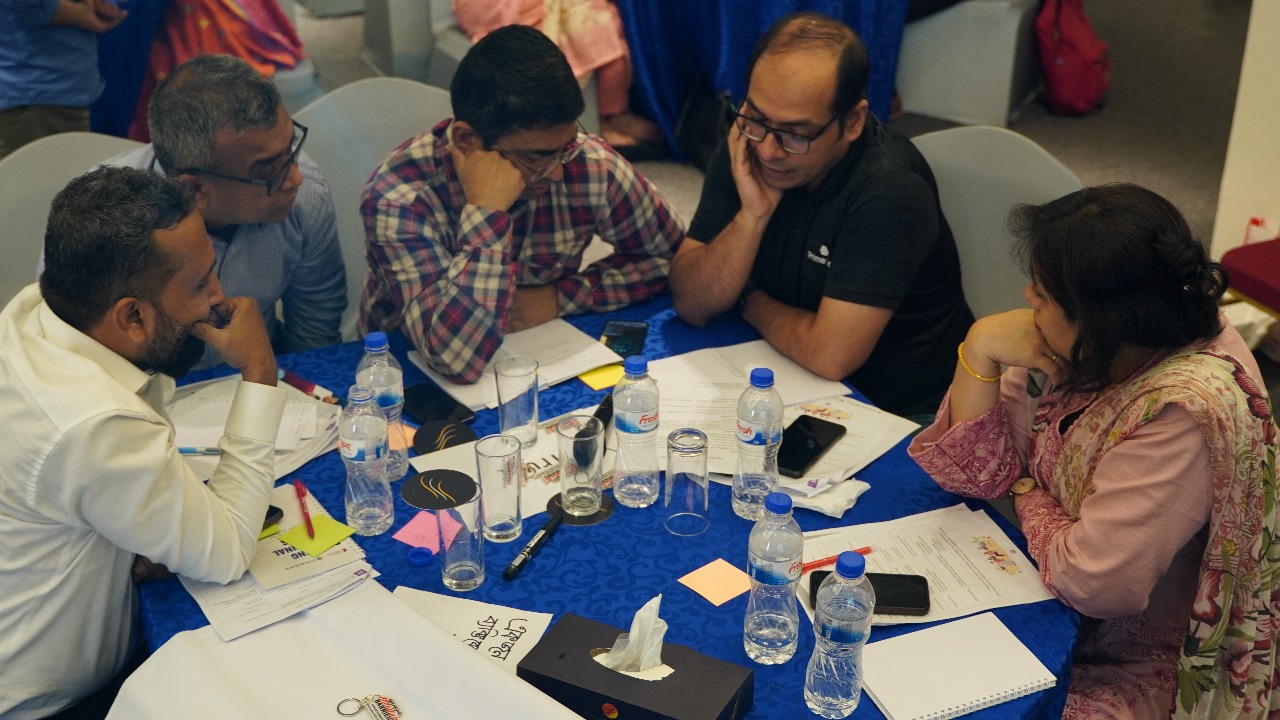




Project Overview
“Inclusion is not a choice; it’s a responsibility, let’s build a world where everyone belongs.”
Inclusion doesn’t begin with policy — it begins with perspective. Recognizing this, Team Inclusion Bangladesh, in partnership with Prime Bank PLC and Monash University, aimed at transforming the banking sector into a more inclusive space for Persons with Disabilities (PWDs), elderly individuals, and pregnant women.
The project was launched following an initial research phase that investigated the persistent exclusion of Persons with Disabilities from formal banking systems in Bangladesh. Despite the presence of progressive national policies and legal frameworks such as the United Nations Convention on the Rights of Persons with Disabilities (UNCRPD), a significant number of Persons with Disabilities remain underserved. The research revealed a crucial insight: beyond physical and systemic challenges, the most entrenched barrier to inclusion is attitudinal, rooted in fear, unconscious bias, and a general lack of awareness and empathy among banking personnel.
In response, the project was aptly titled “Breaking Attitudinal Barriers”, with a focus on transforming mindsets and institutional practices. The initiative consists of two interlinked components



Project Components
The Inclusive Banking Training Module was developed through a participatory, rights-based approach, co-designed by Persons with Disabilities (PWDs) and banking professionals. This collaboration ensured that the module reflected both lived experiences of exclusion and practical realities of the banking sector, resulting in a curriculum that is both empathetic and actionable.
The development process followed the ADDIE instructional design model—encompassing Analysis, Design, Development, Implementation, and Evaluation—to ensure structured content delivery and relevance. It was further guided by the COM-B behavior change model (Capability, Opportunity, and Motivation—Behavior), promoting a shift from awareness to action. Importantly, the Social Model of Disability provided the conceptual foundation, emphasizing that barriers are created not by impairments but by systemic exclusion, attitudes, and inaccessible environments.
The module integrates:
- Legal and Policy Frameworks: Covering UNCRPD, national disability laws, and ethical service guidelines.
- Case Studies: Real-life stories of exclusion, resilience, and expectations from the banking system.
- Inclusive Communication Strategies: Including person-first language, respectful terminology, and introduction to sign language and Braille.
- Empathy-Building Exercises: Such as simulation tasks, role-playing, and sensitivity reflection activities.
- Bias and Attitude Awareness: Sessions on unconscious bias, stereotypes, and attitudinal barriers within banking environments.
- Accessible Banking Practices: Practical guidance on physical infrastructure, customer service adaptations, universal design, and assistive technologies.
- Inclusive Policy and Institutional Change: Tools for building inclusive banking policies, feedback mechanisms, and internal advocacy.
The training module serves as a strategic guide for financial institutions to foster inclusive culture, redesign services, and empower their workforce—ensuring equity, dignity, and accessibility for all customers and employees.
The training module was effectively translated into a three-day, immersive training program designed for 25 banking professionals from Prime Bank PLC. Grounded in the co-developed curriculum, the training brought concepts to life through real-world simulations and participatory methods that prioritized empathy, awareness, and action.
Key sessions included
- Wheelchair Simulation: Participants spent an entire day navigating the training space in wheelchairs to understand the physical and emotional challenges faced by persons with disabilities in banking environments.
- Basic Sign Language Practice: Facilitated by Deaf trainers, this session introduced essential banking-related sign language, enabling participants to communicate more confidently and respectfully with Deaf customers.
- Reverse Role-Playing: Persons with Disabilities assumed the role of bank staff, while participants acted as customers—offering a powerful reflection on assumptions, communication barriers, and unconscious biases.
- Inclusive Language Game: This interactive session focused on recognizing and correcting ableist or stigmatizing language. Through guided activities, participants learned to use respectful, person-first language and apply it in banking contexts to foster more dignified and inclusive customer interactions.
- The Inclusion Tree: In the closing session, each participant made a personal pledge—ranging from improving front-desk behavior to advocating for inclusive hiring—and placed it on a symbolic “Inclusion Tree.” This activity visually reinforced the collective commitment to advancing inclusive banking practices.
Through these sessions, the training empowered participants to move beyond theoretical understanding and into personal reflection and professional action, aiming to transform inclusion from a policy mandate into a daily banking practice.


Training Methodology
The training program was developed through a structured, inclusive approach that integrated instructional design principles with the lived experiences of Persons with Disabilities (PWDs). Framed as a strategic intervention, the program employed a combination of four key models—ADDIE (Analysis, Design, Development, Implementation, Evaluation), COM-B (Capability, Opportunity, Motivation–Behavior), the Social Model of Disability, and Kirkpatrick’s Four Levels of Evaluation—to ensure relevance, behavioral impact, and long-term institutional change. This integrated framework guided both the creation of an innovative, experience-based training module and its delivery through participatory and empathetic learning methods. Notably, this was Bangladesh’s first corporate training where participants spent an entire day in wheelchairs, marking a groundbreaking approach to building empathy and challenging attitudinal barriers within the banking sector.
- ADDIE Model (Analysis, Design, Development, Implementation, Evaluation):
This instructional design framework guided the entire training lifecycle—from identifying needs to evaluating outcomes. It ensured the training was rooted in context, thoughtfully developed, and continuously refined based on feedback. - COM-B Model (Capability, Opportunity, Motivation – Behavior):
This behavioral change model helped assess what banking professionals need to do, and what hinders or supports their inclusive behavior. The training content was designed to enhance capability, create enabling environments, and foster intrinsic motivation for inclusive practices. - Social Model of Disability:
Moving away from the outdated medical view of disability, this model framed disability as a consequence of systemic barriers—physical, attitudinal, and institutional. This perspective helped participants shift their understanding toward rights-based, dignity-first inclusion. - Kirkpatrick’s Four Levels of Evaluation (Reaction, Learning, Behavior, Results):
This evaluation model was integrated to measure the impact of the training systematically. It assessed how participants reacted to the training, what they learned, how their behavior changed, and the tangible outcomes within their professional environments. This model helped capture both immediate feedback and long-term behavioral shifts, ensuring that the training led to meaningful action in real banking contexts.


Impact Evaluation
The effectiveness of the training was assessed using Kirkpatrick’s Four Levels of Evaluation, which allowed for a multi-dimensional understanding of the program’s influence:
- Level 1 – Reaction:
Participants expressed overwhelmingly positive feedback. Many described the training as transformative particularly the wheelchair experience, reverse role-play, and sign language practice. They noted the importance of interacting with PWDs as trainers, which broke stereotypes and built empathy.
- Level 2 – Learning:
There was a significant rise in participants’ understanding of disability rights, inclusive banking policies, and accessibility frameworks.
- Knowledge increased from 42% to 86%, as measured through structured evaluations.
- Level 3 – Behavior:
Participants’ confidence in applying inclusive practices improved dramatically.
- Self-reported capability to communicate with and serve PWDs rose from 31% to 92%.
Many shared action plans for branch-level accessibility audits, awareness sessions for peers, and introducing accessible services.
- Level 4 – Results:
Participants showed a strong intent to apply their learning:
- Behavioral commitment rose from 38% to 87%.
These included efforts to develop inclusive digital platforms, propose disability-friendly products, and advocate for inclusive hiring within Prime Bank.
These outcomes illustrate a shift not just in awareness but in mindset, empathy, and readiness to act. Participants began to see Persons with Disabilities (PWDs) not as passive recipients of aid but as active citizens, skilled professionals, and valuable customers.
Additionally, the training recognized that elderly individuals and pregnant women, who may experience temporary or situational disabilities, also face similar exclusion in banking environments. Inclusive design and service delivery benefit a wide spectrum of customers and staff alike.
The emotional conclusion of the training—the Inclusion Tree—captured this transformation. Each pledge placed on the tree reflected a tangible, personal commitment to advancing inclusion within financial services. One participant wrote: “From now on, I will ensure our front desk is accessible and our communication respectful to every customer.”
Together, these two components reposition disability inclusion from being merely a matter of compliance to a strategic institutional priority one rooted in dignity, equity, empowerment, and long-term organizational transformation. The approach emphasizes not only the rights of Persons with Disabilities (PWDs), but also ensures accessible services for elderly individuals and pregnant women, who may experience temporary or situational disabilities, recognizing their equal need for inclusive and respectful banking environments


Project Objectives
- To identify and address the root causes of exclusion faced by Persons with Disabilities in banking services, with a focus on the attitudinal barriers identified during the initial research phase.
- To develop and implement a practical, rights-based, and context-sensitive training module that enables banking professionals to recognize, unlearn, and shift exclusionary behaviors.
- To foster empathy, awareness, and effective communication skills among banking personnel through experiential learning, including direct engagement with Persons with Disabilities as facilitators and trainers.
- To build institutional capacity for delivering inclusive banking services by equipping staff with tools and frameworks to ensure accessibility, inclusive communication, and policy adherence.
- To promote inclusive employment by positioning Persons with Disabilities not only as customers but also as competent colleagues, trainers, and future leaders in the financial sector.
- To evaluate shifts in knowledge, attitude, and behavior using both qualitative and quantitative tools, including the Kirkpatrick Model and COM-B Framework, ensuring a deeper understanding of behavior change.
- To drive systemic transformation within banking institutions by embedding inclusive practices into daily operations, customer engagement, product development, recruitment, and long-term planning.


Methodology
The project followed a structured instructional design process using the ADDIE Model—Analysis, Design, Development, Implementation, and Evaluation—to guide the development and delivery of both the training module and the subsequent workshop. To ensure meaningful behavior change, the COM-B Model (Capability, Opportunity, and Motivation – Behavior) was also integrated, shaping the design of interactive sessions and participatory tools. Additionally, the Social Model of Disability was embedded throughout the content and delivery approach to center the removal of societal barriers rather than focusing solely on individual impairments.
Evaluation of the project was guided by Kirkpatrick’s Four Levels of Training Evaluation—Reaction, Learning, Behavior, and Results—providing a comprehensive framework to assess the overall effectiveness and institutional impact of the training intervention and module deployment.


Overall Findings
The project, “Breaking Attitudinal Barriers: Inclusive Banking for Persons with Disabilities,” yielded several significant insights across its research, module development, and training implementation phases. These findings highlight key areas of progress, persistent challenges, and strategic opportunities for advancing disability-inclusive banking in Bangladesh. The points below summarize the core takeaways from the initiative:
1. Attitudinal Barriers Identified as the Core Challenge
The project’s initial research phase revealed that while physical and systemic barriers exist, attitudinal barriers such as unconscious bias, lack of awareness, and discomfort, and assumptions about ability are the most persistent obstacles to financial inclusion for Persons with Disabilities (PWDs).
2. Inclusion Must Extend beyond Persons with Disabilities (PWDs)
The training emphasized that elderly individuals and pregnant women, who may experience temporary or situational disabilities, also face exclusion in conventional banking environments. Inclusive banking practices must recognize and respond to their needs with equal priority.
3. Effective Co-Design of Training Module
A comprehensive training module was co-developed with Persons with Disabilities (PWDs) and banking professionals, integrating the ADDIE instructional model, the COM-B behavioral change model, the Social Model of Disability, and Kirkpatrick’s Four Levels of Evaluation. The module provided practical learning tools, inclusive communication strategies, legal and policy awareness, and empathy-building exercises to support inclusive banking practices.
4. Transformational Learning through Immersive Experience
The training included impactful components—such as full-day wheelchair immersion, sign language learning, and reverse role-playing session—that helped participants internalize the lived experiences of exclusion and reflect critically on personal and institutional biases.
5. Measurable Shifts in Knowledge, Attitude, and Confidence
Post-training evaluation revealed clear improvements:
- Understanding of disability rights and inclusive banking increased significantly.
- Empathy and attitudinal readiness toward Persons with Disabilities (PWDs) showed strong growth.
- Confidence in communicating with and serving diverse customers improved.
- Intent to apply inclusive practices in professional roles was visibly strengthened.
6. Commitment to Institutional Change
The Inclusion Tree exercise gathered personal pledges from participants, including:
- Improving front-desk interactions,
- Proposing inclusive financial products and accessible digital services,
- Advocating for disability awareness training and inclusive recruitment within their institutions.
7. Inclusion Framed as a Strategic and Economic Imperative
The project emphasized that financial inclusion is not only a human rights issue but also a smart business strategy. Enabling full participation of Persons with Disabilities (PWDs) in the economy can drive institutional innovation and national economic growth.
8. Need for Sustained Action Beyond the Training
While the training demonstrated powerful short-term changes, long-term transformation requires:
- Continuous upskilling of staff,
- Embedding inclusion in institutional policies and operational plans,
- Applying structured evaluation frameworks like Kirkpatrick’s Model to track progress and impact.


Recommendations
To ensure sustainable, impactful, and institutionally embedded inclusive banking practices, the following recommendations are proposed based on the training and module development experience:
- Institutionalize Disability Inclusion Policies
Develop and implement comprehensive inclusion policies within financial institutions that explicitly address the rights and needs of Persons with Disabilities (PWDs), elderly individuals, and pregnant women. This includes embedding inclusive practices into recruitment, customer service, infrastructure, and product design. - Mandatory Inclusion Training for All Staff
Scale up training programs based on the developed module to include all frontline and backend staff. Regular refresher courses should be included to ensure sustainability and deeper cultural transformation. - Appoint Disability Focal Persons at Branch Level
Designate trained personnel in each branch to serve as accessibility focal points—ensuring responsive service, advocating for inclusion, and acting as internal champions. - Ensure Physical and Digital Accessibility
Upgrade bank infrastructure (e.g., ramps, signage, accessible counters) and digital platforms (e.g., screen readers, accessible apps) to be universally usable by PWDs, elderly clients, and pregnant women. - Inclusive Communication Tools and Services
Integrate sign language services, braille documentation, large print forms, and alternative communication tools into daily operations. Staff should be trained in basic inclusive communication techniques. - Inclusive Product Development
Design financial products and services tailored to the needs of diverse clients, including microcredit, savings, insurance, or loan products accessible to PWDs and elderly individuals. - Employ Persons with Disabilities in Banking Sector
Prioritize inclusive hiring practices, ensuring Persons with Disabilities are employed, retained, and supported in leadership pipelines within financial institutions. - Monitor and Evaluate Impact Using Kirkpatrick Model
Continue applying the Kirkpatrick Four-Level Evaluation Model (Reaction, Learning, Behavior, Results) to measure training impact at individual and institutional levels and refine future interventions accordingly. - Collaborate with Persons with Disabilities (PWDs)-Led or Focused Organizations
Strengthen partnerships with DPOs and community organizations to co-create solutions, validate approaches, and expand outreach to marginalized groups. - Annual Action Plan for Inclusive Banking
Set annual targets and reporting mechanisms to track progress on inclusive banking goals, backed by allocated budgets and performance metrics.

Get Involved
“Interested in implementing inclusive banking training in your organization? Contact us.”
